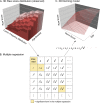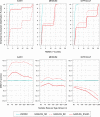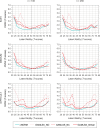Continuous norming of psychometric tests: A simulation study of parametric and semi-parametric approaches
- PMID: 31527877
- PMCID: PMC6748442
- DOI: 10.1371/journal.pone.0222279
Continuous norming of psychometric tests: A simulation study of parametric and semi-parametric approaches
Abstract
Continuous norming methods have seldom been subjected to scientific review. In this simulation study, we compared parametric with semi-parametric continuous norming methods in psychometric tests by constructing a fictitious population model within which a latent ability increases with age across seven age groups. We drew samples of different sizes (n = 50, 75, 100, 150, 250, 500 and 1,000 per age group) and simulated the results of an easy, medium, and difficult test scale based on Item Response Theory (IRT). We subjected the resulting data to different continuous norming methods and compared the data fit under the different test conditions with a representative cross-validation dataset of n = 10,000 per age group. The most significant differences were found in suboptimal (i.e., too easy or too difficult) test scales and in ability levels that were far from the population mean. We discuss the results with regard to the selection of the appropriate modeling techniques in psychometric test construction, the required sample sizes, and the requirement to report appropriate quantitative and qualitative test quality criteria for continuous norming methods in test manuals.
Conflict of interest statement
cNORM was developed by the authors and is freely available and licensed under the GNU Affero General Public License v3 (AGPL-3.0). We do not pursue economic interests with this publication. The authors have declared that no competing interests exist.
Figures










References
-
- American Psychiatric Association, American Psychiatric Association, Editor. Diagnostic and statistical manual of mental disorders: DSM-5. 5th ed. Washington, D.C: American Psychiatric Association; 2013.
-
- Rutter M, Tizard J, Yule W, Graham P, Whitmore K. Isle of Wight Studies, 1964–1974. Psychological Medicine. 1976;6(02):313. - PubMed
-
- Oosterhuis HEM, van der Ark LA, Sijtsma K. Standard errors and confidence intervals of norm statistics for educational and psychological Tests. Psychometrika. September 2017;82(3):559–88. - PubMed
-
- Zhu J, Chen H-Y. Utility of inferential norming with smaller sample sizes. Journal of Psychoeducational Assessment. December 2011;29(6):570–80.
Publication types
MeSH terms
LinkOut - more resources
Full Text Sources

